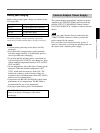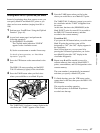
44 Chapter 3 Shooting
Chapter 3 Shooting
1) Hunting: This occurs if the automatic iris function is not
able to reach a stable state, and as a result the image
brightness keeps changing, alternately lighter and darker.
2) Depth of field: This is the range over which the subject
is sharply in focus.
..........................................................................................................................................................................................................
Filter setting
Lighting conditions
1 (3200K) Studio halogen lighting (incandescent),
sunrise and sunset.
2 (5600K +
1
/8
ND)
Sunlight.
This setting includes a
1
/8 neutral density
filter (reducing the exposure by the
equivalent of three stops). Use it to prevent
hunting
1)
or to reduce the depth of field
2)
.
3 (5600K) Cloudy or rainy outdoor shooting, and
fluorescent lighting.
4 (5600K +
1
/64ND)
Sunlight.
This setting includes a
1
/64 neutral density
filter (reducing the exposure by the
equivalent of six stops). Use it to prevent
hunting
1)
or to reduce the depth of field
2)
.
3 Check the switch settings on the camera head.
(See pages 13 to 18.)
If there is not sufficient time to check the camera
settings, you can use “easy mode” by setting the
EZ MODE switch to the ON position. The camera
is automatically adjusted to standard settings, and
the iris and the white balance are adjusted
automatically. (See page 68.)
4 Check the settings in the basic menu (page 58) and
advanced menu (page 64).
5 Check the lens settings (pages 30 and 31) and
flange focal length adjustment (page 89).
6 Adjust the eyepiece focus, and the contrast and
brightness of the viewfinder image (page 88).
7 Check the sound system settings.
• Microphone connections
• Settings on the VTR (refer to the VTR
instructions)
8 If required, switch on the center marker and/or
safety zone (basic menu page 5 and advanced
menu page 4) and zebra pattern (ZEBRA switch)
in the viewfinder image.
9 Adjust the white balance (page 79) and black
balance (page 83).
10Turn the focusing ring so that the subject is
sharply in focus. It may be convenient to use the
EZ FOCUS button for the “easy focus” function
(see page 14).
11Set up the VTR according to your shooting
objectives, then start recording.
If a camera control unit is not connected: Press
the VTR button on the camera head or on the
lens.
If a camera control unit is connected: Press the
VTR’s record button to begin recording.
For details of VTR setup and operations, see your
VTR’s operating instructions.
• During recording, the REC/TALLY indicator(s)
in the viewfinder light(s), and “REC” appears on
the viewfinder screen.
• Depending on the setting of the REC TIME
switch (See page 15), you can display the total
recording time or the length of the camera cut on
the viewfinder screen.
• When recording on the DSR-1/1P, you can use
the AUDIO LEVEL knob on the front of the
camera head to manually adjust the channel 1
audio level. To do this, you must first set up the
DSR-1/1P to enable manual adjustment of the
audio recording level.
For details of this operation, see the operating
instructions for the DSR-1/1P.
12To pause recording, press the VTR button again.
Basic Procedure for Shooting


















